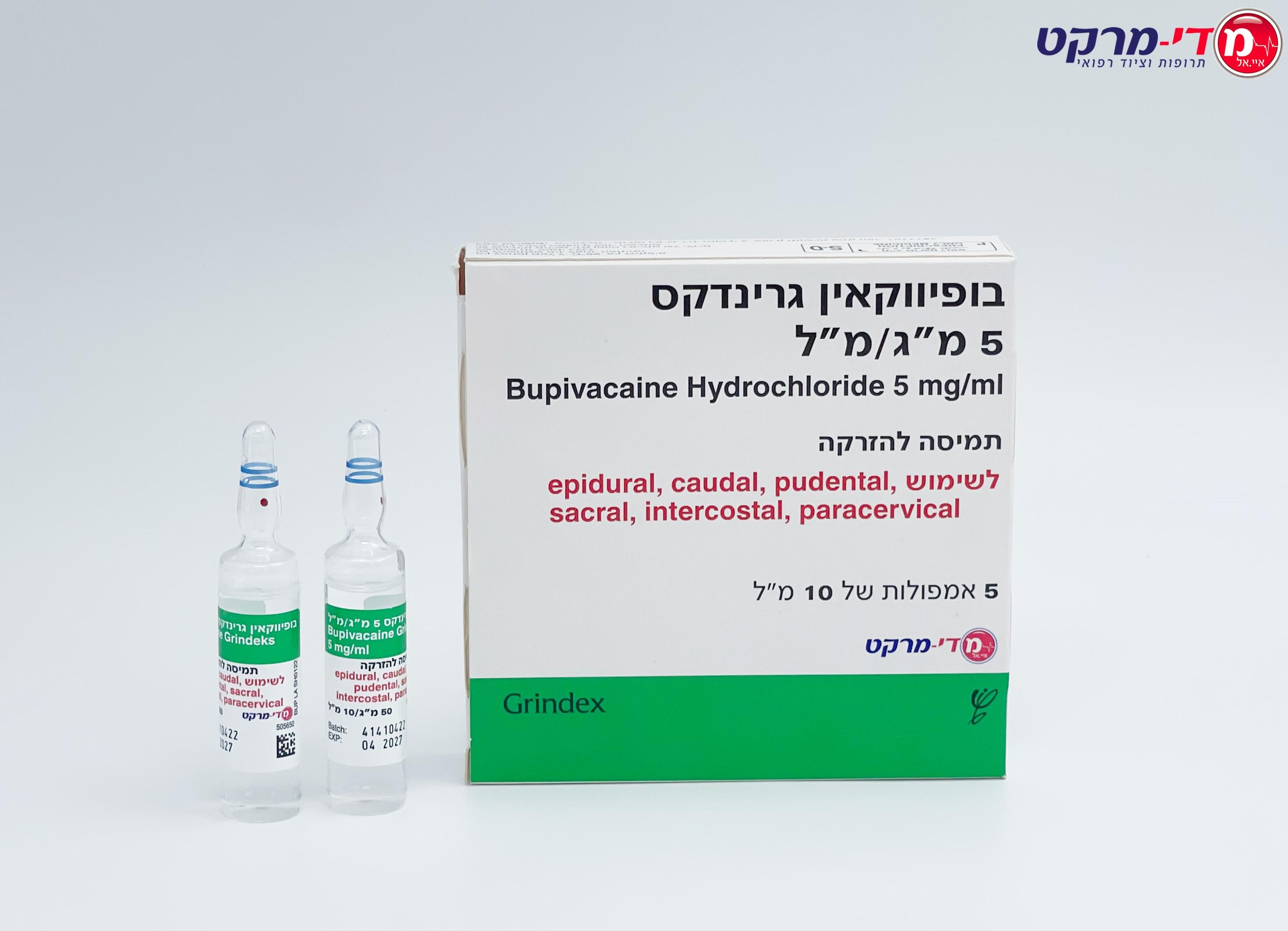Quest for the right Drug

בופיווקאין גרינדקס 5 מ"ג/מ"ל BUPIVACAINE GRINDEKS 5 MG/ML (BUPIVACAINE HYDROCHLORIDE)
תרופה במרשם
תרופה בסל
נרקוטיקה
ציטוטוקסיקה
צורת מתן:
זריקה באזור צוואר הרחם, לעצבי הצלעות, לאגן, לתוך עצב, לתוך הזנבעצם הזנב, אפידורל : PARACERVICAL, INTERCOSTAL, SACRAL, PUDENTAL, CAUDAL, EPIDURAL
צורת מינון:
תמיסה להזרקה : SOLUTION FOR INJECTION
עלון לרופא
מינוניםPosology התוויות
Indications תופעות לוואי
Adverse reactions התוויות נגד
Contraindications אינטראקציות
Interactions מינון יתר
Overdose הריון/הנקה
Pregnancy & Lactation אוכלוסיות מיוחדות
Special populations תכונות פרמקולוגיות
Pharmacological properties מידע רוקחי
Pharmaceutical particulars אזהרת שימוש
Special Warning עלון לרופא
Physicians Leaflet
Overdose : מינון יתר
4.9 Overdose Acute systemic toxicity: Symptoms: Systemic toxic reactions involve the central nervous system and the cardiovascular system. These reactions are caused by high blood concentrations of local anaesthetic, which can occur as a result of inadvertent intravascular injection, overdose or unusually rapid absorption from highly vascularised tissue (see also section 4.4 Special warnings and precautions for use). CNS symptoms are similar for all amide-type local anaesthetics, while cardiac symptoms differ between different medicinal products, both quantitatively and qualitatively. Inadvertent intravascular injections of local anaesthetics can cause immediate systemic toxic reactions (within seconds to a few minutes). Signs of systemic toxicity in the case of overdose occur later (15-60 minutes after injection) due to a slower increase in concentrations of local anaesthetic in the blood. CNS toxicity occurs gradually, with symptoms and reactions of escalating severity. The initial symptoms are usually a feeling of intoxication, circumoral paraesthesia, numbness of the tongue, hyperacousis, tinnitus and visual disturbances. Difficulty in articulating, muscle spasms or tremor are more severe symptoms and precede generalised convulsions. These symptoms must not be interpreted as neurotic behaviour. Unconsciousness and grand mal convulsions may follow the symptoms listed above, and may last from a few seconds to several minutes. Hypoxia and hypercapnia develop rapidly, with subsequent convulsions due to increased muscular activity and insufficient ventilation. In severe cases, respiratory arrest may occur. Acidosis intensifies the toxic effects of local anaesthetics. Recovery is dependent on the metabolism of the local anaesthetic agent and on distribution away from the central nervous system. The process is rapid unless very large amounts of the drug have been injected. Cardiovascular effects usually indicate a more serious situation and are usually preceded by signs of CNS toxicity, however these can be masked by general anaesthesia or heavy sedation with drugs such as benzodiazepines or barbiturates. Blood pressure drops, bradycardia, arrhythmia and even cardiac arrest can occur as a result of high systemic concentrations of local anaesthetics. Cardiovascular toxic effects are often related to depression of the conduction system of the heart and myocardium, leading to decreased minute volume, hypotension, AV block, bradycardia and sometimes ventricular arrhythmias including ventricular tachycardia, ventricular fibrillation and cardiac arrest. These conditions are often preceded by signs of severe CNS toxicity such as convulsions, but in rare cases cardiac arrest has occurred in the absence of prodromal CNS effects. Following a very rapid intravenous bolus injection, the blood concentrations of bupivacaine can be so high in the coronary vessels that circulatory effects arise, alone or preceding CNS effects. Myocardial depression can occur via this mechanism, potentially as the initial symptom of toxicity. Extra attention must be paid to early signs of toxicity in pediatric patients, as children do not usually receive large blocks until after general anaesthesia has been initiated. Treatment: Adequate ventilation (free airways, oxygen, and intubation and controlled respiration if required ) must be ensured in the case of total spinal blockade. In the event of a fall in blood pressure or bradycardia, administer a vasopressor, preferably with an inotropic effect. If signs of acute systemic toxicity occur, the administration of local anaesthetic agents must be stopped immediately and CNS symptoms (convulsion, CNS depression) must promptly be treated with appropriate oxygen supply/ventilation support and the administration of anticonvulsant drugs. If cardiovascular arrest occurs (hypotension, bradycardia), appropriate treatment with intravenous fluids, vasopressor, inotropic agents and/or lipid emulsion should be considered. Children must be given doses proportional to their age and body weight when treating systemic toxicity. If circulatory arrest should occur, immediate cardiopulmonary resuscitation should be instituted. Optimal oxygenation, ventilation and circulatory support as well as treatment of acidosis are of vital importance. Extended resuscitation may be warranted in the case of circulatory arrest.

שימוש לפי פנקס קופ''ח כללית 1994
לא צוין
תאריך הכללה מקורי בסל
לא צוין
הגבלות
לא צוין
מידע נוסף
עלון מידע לרופא
13.03.22 - עלון לרופאעלון מידע לצרכן
לתרופה במאגר משרד הבריאות
בופיווקאין גרינדקס 5 מ"ג/מ"ל